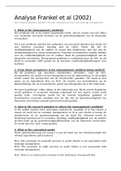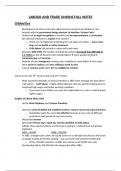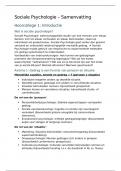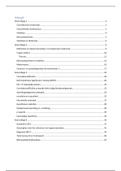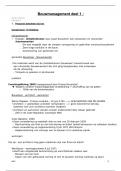Cliëntgerichte psychotherapie
Cliëntgerichte psychotherapie ................................................................................................................ 1
Inleiding ................................................................................................................................................... 5
1. Oriëntering Cliëntgerichte Psychotherapie ..................................................................................... 5
2. Humanistisch-experiëntiële mensbeeld .......................................................................................... 5
3. Van een mensbeeld naar attitudes en interventies ........................................................................ 6
4. Historische schets van cliëntgerichte psychotherapie .................................................................... 6
4.1 Carl Rogers (1902 – 1987) ......................................................................................................... 7
5. Enkele basisideeën van de cliëntgerichte psychotherapie ............................................................. 7
6. Evolutie van de cliëntgerichte psychotherapie ............................................................................... 8
7. Het cliëntgerichte therapeutische proces ....................................................................................... 9
8. Fases van cliëntgerichte psychotherapie ........................................................................................ 9
8.1 Faseringsmodellen..................................................................................................................... 9
8.1.1 Fasering Barret-Lennard (1990) ....................................................................................... 10
De existentiële of macro-dimensie ....................................................................................................... 14
1. Transdiagnostisch & procesdiagnostisch werken ......................................................................... 14
2. Waarom twee lessen over de existentiële dimensie?................................................................... 14
3. De existentiële of macro- dimensie............................................................................................... 15
3.1 Existential givens ..................................................................................................................... 16
3.1.1 Dood en leven.................................................................................................................. 16
3.1.2 Existentiële eenzaamheid en verbondenheid .................................................................. 18
3.1.3 Zinloosheid en zingeving .................................................................................................. 19
3.1.4 Vrijheid, keuze en verantwoordelijkheid ......................................................................... 21
3.2 De bestaansdimensies ............................................................................................................. 22
3.2.1 Fysieke dimensie van ons bestaan ................................................................................... 22
3.2.2 Sociale dimensie ............................................................................................................... 22
3.2.3 Persoonlijke dimensie ...................................................................................................... 22
3.2.4 Spirituele dimensie ........................................................................................................... 23
Grondhoudingen ................................................................................................................................... 24
1. Inleiding ......................................................................................................................................... 24
1.1 Grondhoudingen ..................................................................................................................... 24
1.2 Andere formulering van de therapeutische relatie ................................................................. 24
1.3 Andere aspecten van de therapeutische relatie ..................................................................... 25
2. Reflectie en oefening..................................................................................................................... 26
3. Onvoorwaardelijke aanvaarding ................................................................................................... 26
1
, 3.1 Basistheorie en pathogenese Rogers (later bijgesteld) ........................................................... 26
3.2 Innerlijke criticus ..................................................................................................................... 28
3.2.1 Casus “Mijn lelijk vierjarig kind” ....................................................................................... 29
4. Echtheid ......................................................................................................................................... 29
4.1 Congruentie ............................................................................................................................. 30
4.2 Transparantie .......................................................................................................................... 30
4.3 Authenticiteit........................................................................................................................... 31
4.3.1 Relational depth ............................................................................................................... 31
5. Empathie ....................................................................................................................................... 32
5.1 Empathische afstemming op beleving van de ander .............................................................. 33
5.2 Empathie in actie ..................................................................................................................... 33
5.3 Functies van empathie ............................................................................................................ 34
6. Casussen ........................................................................................................................................ 34
6.1 Casus Miss Mun ....................................................................................................................... 34
6.2 Casus Dione – On anger and hurt ............................................................................................ 36
Experiëntiëel werken: focusing en focusing-oriented therapy (FOT) ................................................... 37
1. Inleiding ......................................................................................................................................... 37
1.1 Verandering ............................................................................................................................. 37
1.2 Substromingen cliëntgerichte psychotherapie (niet exhaustief) ............................................ 38
2. Focusing als een bijzondere vorm van contacteren, ontmoeten, zelf- exploratie en méér ......... 38
2.1 Vroeg therapie-onderzoek ...................................................................................................... 38
2.2 Experiencing scale (levels) ....................................................................................................... 39
2.3 Concrete experiëntiële interventies ........................................................................................ 39
2.4 Focusing ................................................................................................................................... 40
3. Focusing in actie ............................................................................................................................ 40
3.1 Focusing steps (Gendlin, 1978) ............................................................................................... 40
3.1.1 Ruimte maken (bij overregulatie)..................................................................................... 40
3.1.2 Felt sense laten komen..................................................................................................... 41
3.1.3 Een handvat vinden (symbolisering) ................................................................................ 41
3.1.4 Resoneren......................................................................................................................... 41
3.1.5 Vragen/exploreren ........................................................................................................... 41
3.1.6 Ontvangen ........................................................................................................................ 41
3.2 Focussen .................................................................................................................................. 41
3.3 Felt sense ................................................................................................................................. 42
3.4 Felt shift ................................................................................................................................... 42
4. Focusing-oriented therapy (FOT) en Experiential-existential Psychotherapy (EEP) ..................... 42
2
, 4.1 Focusing-oriented therapy (FOT) ............................................................................................ 42
4.2 Experiential-existential psychotherapy (EEP) .......................................................................... 43
5. Casus .............................................................................................................................................. 43
Experiëntiëel werken: Emotion-focused therapy (EFT) ........................................................................ 44
1. Inleiding ......................................................................................................................................... 44
2. EFT en emoties .............................................................................................................................. 44
2.1 Basis en complexere emoties .................................................................................................. 45
2.2 Adaptief versus mal-adaptief .................................................................................................. 45
2.3 Secundaire mal-adaptieve emoties ......................................................................................... 45
2.4 Instrumentele emoties ............................................................................................................ 45
3. Emotion-focused therapy .............................................................................................................. 45
4. Casus EFT ....................................................................................................................................... 47
5. Emotionally-focused therapy ........................................................................................................ 47
6. FOT en EFT ..................................................................................................................................... 48
Cliëntgerichte - experiëntiële - existentiële groepstherapie................................................................. 50
1. Groepstherapie vs. individuele therapie ....................................................................................... 50
2. Indicatiestelling ............................................................................................................................. 50
3. Groepsdynamica en groepstherapie ............................................................................................. 50
4. De groepstherapeut ...................................................................................................................... 52
5. Groepsontwikkeling....................................................................................................................... 52
5.1 Lineaire modellen Yalom, Tuckman ........................................................................................ 53
5.2 Spiraalmodel: Focaal conflict model van Whitaker en Lieberman .......................................... 54
5.3 Extra aandacht voor zondebok/scapegoating ......................................................................... 54
6. Enkele existentiële lagen in groepstherapie ................................................................................. 55
6.1 Existentieel: ontmoeting ......................................................................................................... 55
6.3 Enkele andere existentiële thema’s ........................................................................................ 56
Experiëntieel-existentieel werken bij mensen met levensbedreigende aandoeningen ....................... 57
1. Existentiële psychotherapie bij mensen die levensbedreigend ziek zijn ...................................... 57
1.1 Existentie - Viktor Frankl (logotherapie) ................................................................................. 58
1.2 Existentiële therapie – Irvin Yalom (existentiële groepstherapie) .......................................... 58
1.3 Meaning Centered psychotherapie ......................................................................................... 59
1.3.1 Meaning Centered psychotherapie bij palliatieve patiënten – William Breitbart ........... 59
1.3.2 Meaning centered therapy for cancer survivors – Nadia Van der Spek........................... 59
1.4 Dignity therapy bij terminaal zieke patiënten - Chochinov ..................................................... 59
1.5 Experiëntiële benadering ........................................................................................................ 59
1.6 Gendlin - Focusing ................................................................................................................... 60
3
, 2. Experiëntieel-existentiële therapie ............................................................................................... 60
3. Protocol experiëntieel-existentiële groepstherapie...................................................................... 61
4. Casussen ........................................................................................................................................ 63
Cliëntgerichte therapie voor psychose-gevoelige mensen ................................................................... 66
1. Psychosezorg en CGT ..................................................................................................................... 66
1.1 Psychose(zorg) is een strijd om het recht op beleving. ........................................................... 66
1.2 Goede zorg ondersteunt persoonlijk herstel........................................................................... 67
1.3 Onze grondleggers gingen op avontuur in de psychosezorg. ................................................. 68
2. Cliëntgerichte vaardigheden ......................................................................................................... 69
2.1 Contactniveau herstellen ........................................................................................................ 69
2.2 Contactreflecties ..................................................................................................................... 71
2.3 Buitengewone zintuiglijke ervaringen doorwerken ................................................................ 72
2.4 Aanbod volgens herstelfase .................................................................................................... 73
2.5 Werkzaamheden ..................................................................................................................... 74
De interactionele substroming en integratie ........................................................................................ 75
1. Inleiding ......................................................................................................................................... 75
2. De interactionele substroming ...................................................................................................... 75
2.1 Problemen en problematieken zijn interactioneel.................................................................. 76
2.2 Het probleem doet zich voor in de interactie in de therapie zelf ........................................... 76
3. Casussen ........................................................................................................................................ 76
4. De tweedimensionele interactionele classificatie ......................................................................... 77
5. Integratie: Casus Sofie ................................................................................................................... 78
6. Een recente therapie-sessie .......................................................................................................... 82
Empirische ondersteuning en meta-reflectie ........................................................................................ 83
1. Inleiding ......................................................................................................................................... 83
2. Onderzoek grondhoudingen ......................................................................................................... 83
3. Onderzoek experiëntieel werken .................................................................................................. 84
4. Humanistisch-experiëntiële psychotherapieën zijn evidence-based ............................................ 85
4.1 Andere zelf-beleving................................................................................................................ 86
4.2 Zichzelf anders beleven in relatie tot anderen ........................................................................ 86
4.3 Ander zicht op zichzelf en anderen ......................................................................................... 86
5. Meta-reflectie ................................................................................................................................ 86
4
Cliëntgerichte psychotherapie ................................................................................................................ 1
Inleiding ................................................................................................................................................... 5
1. Oriëntering Cliëntgerichte Psychotherapie ..................................................................................... 5
2. Humanistisch-experiëntiële mensbeeld .......................................................................................... 5
3. Van een mensbeeld naar attitudes en interventies ........................................................................ 6
4. Historische schets van cliëntgerichte psychotherapie .................................................................... 6
4.1 Carl Rogers (1902 – 1987) ......................................................................................................... 7
5. Enkele basisideeën van de cliëntgerichte psychotherapie ............................................................. 7
6. Evolutie van de cliëntgerichte psychotherapie ............................................................................... 8
7. Het cliëntgerichte therapeutische proces ....................................................................................... 9
8. Fases van cliëntgerichte psychotherapie ........................................................................................ 9
8.1 Faseringsmodellen..................................................................................................................... 9
8.1.1 Fasering Barret-Lennard (1990) ....................................................................................... 10
De existentiële of macro-dimensie ....................................................................................................... 14
1. Transdiagnostisch & procesdiagnostisch werken ......................................................................... 14
2. Waarom twee lessen over de existentiële dimensie?................................................................... 14
3. De existentiële of macro- dimensie............................................................................................... 15
3.1 Existential givens ..................................................................................................................... 16
3.1.1 Dood en leven.................................................................................................................. 16
3.1.2 Existentiële eenzaamheid en verbondenheid .................................................................. 18
3.1.3 Zinloosheid en zingeving .................................................................................................. 19
3.1.4 Vrijheid, keuze en verantwoordelijkheid ......................................................................... 21
3.2 De bestaansdimensies ............................................................................................................. 22
3.2.1 Fysieke dimensie van ons bestaan ................................................................................... 22
3.2.2 Sociale dimensie ............................................................................................................... 22
3.2.3 Persoonlijke dimensie ...................................................................................................... 22
3.2.4 Spirituele dimensie ........................................................................................................... 23
Grondhoudingen ................................................................................................................................... 24
1. Inleiding ......................................................................................................................................... 24
1.1 Grondhoudingen ..................................................................................................................... 24
1.2 Andere formulering van de therapeutische relatie ................................................................. 24
1.3 Andere aspecten van de therapeutische relatie ..................................................................... 25
2. Reflectie en oefening..................................................................................................................... 26
3. Onvoorwaardelijke aanvaarding ................................................................................................... 26
1
, 3.1 Basistheorie en pathogenese Rogers (later bijgesteld) ........................................................... 26
3.2 Innerlijke criticus ..................................................................................................................... 28
3.2.1 Casus “Mijn lelijk vierjarig kind” ....................................................................................... 29
4. Echtheid ......................................................................................................................................... 29
4.1 Congruentie ............................................................................................................................. 30
4.2 Transparantie .......................................................................................................................... 30
4.3 Authenticiteit........................................................................................................................... 31
4.3.1 Relational depth ............................................................................................................... 31
5. Empathie ....................................................................................................................................... 32
5.1 Empathische afstemming op beleving van de ander .............................................................. 33
5.2 Empathie in actie ..................................................................................................................... 33
5.3 Functies van empathie ............................................................................................................ 34
6. Casussen ........................................................................................................................................ 34
6.1 Casus Miss Mun ....................................................................................................................... 34
6.2 Casus Dione – On anger and hurt ............................................................................................ 36
Experiëntiëel werken: focusing en focusing-oriented therapy (FOT) ................................................... 37
1. Inleiding ......................................................................................................................................... 37
1.1 Verandering ............................................................................................................................. 37
1.2 Substromingen cliëntgerichte psychotherapie (niet exhaustief) ............................................ 38
2. Focusing als een bijzondere vorm van contacteren, ontmoeten, zelf- exploratie en méér ......... 38
2.1 Vroeg therapie-onderzoek ...................................................................................................... 38
2.2 Experiencing scale (levels) ....................................................................................................... 39
2.3 Concrete experiëntiële interventies ........................................................................................ 39
2.4 Focusing ................................................................................................................................... 40
3. Focusing in actie ............................................................................................................................ 40
3.1 Focusing steps (Gendlin, 1978) ............................................................................................... 40
3.1.1 Ruimte maken (bij overregulatie)..................................................................................... 40
3.1.2 Felt sense laten komen..................................................................................................... 41
3.1.3 Een handvat vinden (symbolisering) ................................................................................ 41
3.1.4 Resoneren......................................................................................................................... 41
3.1.5 Vragen/exploreren ........................................................................................................... 41
3.1.6 Ontvangen ........................................................................................................................ 41
3.2 Focussen .................................................................................................................................. 41
3.3 Felt sense ................................................................................................................................. 42
3.4 Felt shift ................................................................................................................................... 42
4. Focusing-oriented therapy (FOT) en Experiential-existential Psychotherapy (EEP) ..................... 42
2
, 4.1 Focusing-oriented therapy (FOT) ............................................................................................ 42
4.2 Experiential-existential psychotherapy (EEP) .......................................................................... 43
5. Casus .............................................................................................................................................. 43
Experiëntiëel werken: Emotion-focused therapy (EFT) ........................................................................ 44
1. Inleiding ......................................................................................................................................... 44
2. EFT en emoties .............................................................................................................................. 44
2.1 Basis en complexere emoties .................................................................................................. 45
2.2 Adaptief versus mal-adaptief .................................................................................................. 45
2.3 Secundaire mal-adaptieve emoties ......................................................................................... 45
2.4 Instrumentele emoties ............................................................................................................ 45
3. Emotion-focused therapy .............................................................................................................. 45
4. Casus EFT ....................................................................................................................................... 47
5. Emotionally-focused therapy ........................................................................................................ 47
6. FOT en EFT ..................................................................................................................................... 48
Cliëntgerichte - experiëntiële - existentiële groepstherapie................................................................. 50
1. Groepstherapie vs. individuele therapie ....................................................................................... 50
2. Indicatiestelling ............................................................................................................................. 50
3. Groepsdynamica en groepstherapie ............................................................................................. 50
4. De groepstherapeut ...................................................................................................................... 52
5. Groepsontwikkeling....................................................................................................................... 52
5.1 Lineaire modellen Yalom, Tuckman ........................................................................................ 53
5.2 Spiraalmodel: Focaal conflict model van Whitaker en Lieberman .......................................... 54
5.3 Extra aandacht voor zondebok/scapegoating ......................................................................... 54
6. Enkele existentiële lagen in groepstherapie ................................................................................. 55
6.1 Existentieel: ontmoeting ......................................................................................................... 55
6.3 Enkele andere existentiële thema’s ........................................................................................ 56
Experiëntieel-existentieel werken bij mensen met levensbedreigende aandoeningen ....................... 57
1. Existentiële psychotherapie bij mensen die levensbedreigend ziek zijn ...................................... 57
1.1 Existentie - Viktor Frankl (logotherapie) ................................................................................. 58
1.2 Existentiële therapie – Irvin Yalom (existentiële groepstherapie) .......................................... 58
1.3 Meaning Centered psychotherapie ......................................................................................... 59
1.3.1 Meaning Centered psychotherapie bij palliatieve patiënten – William Breitbart ........... 59
1.3.2 Meaning centered therapy for cancer survivors – Nadia Van der Spek........................... 59
1.4 Dignity therapy bij terminaal zieke patiënten - Chochinov ..................................................... 59
1.5 Experiëntiële benadering ........................................................................................................ 59
1.6 Gendlin - Focusing ................................................................................................................... 60
3
, 2. Experiëntieel-existentiële therapie ............................................................................................... 60
3. Protocol experiëntieel-existentiële groepstherapie...................................................................... 61
4. Casussen ........................................................................................................................................ 63
Cliëntgerichte therapie voor psychose-gevoelige mensen ................................................................... 66
1. Psychosezorg en CGT ..................................................................................................................... 66
1.1 Psychose(zorg) is een strijd om het recht op beleving. ........................................................... 66
1.2 Goede zorg ondersteunt persoonlijk herstel........................................................................... 67
1.3 Onze grondleggers gingen op avontuur in de psychosezorg. ................................................. 68
2. Cliëntgerichte vaardigheden ......................................................................................................... 69
2.1 Contactniveau herstellen ........................................................................................................ 69
2.2 Contactreflecties ..................................................................................................................... 71
2.3 Buitengewone zintuiglijke ervaringen doorwerken ................................................................ 72
2.4 Aanbod volgens herstelfase .................................................................................................... 73
2.5 Werkzaamheden ..................................................................................................................... 74
De interactionele substroming en integratie ........................................................................................ 75
1. Inleiding ......................................................................................................................................... 75
2. De interactionele substroming ...................................................................................................... 75
2.1 Problemen en problematieken zijn interactioneel.................................................................. 76
2.2 Het probleem doet zich voor in de interactie in de therapie zelf ........................................... 76
3. Casussen ........................................................................................................................................ 76
4. De tweedimensionele interactionele classificatie ......................................................................... 77
5. Integratie: Casus Sofie ................................................................................................................... 78
6. Een recente therapie-sessie .......................................................................................................... 82
Empirische ondersteuning en meta-reflectie ........................................................................................ 83
1. Inleiding ......................................................................................................................................... 83
2. Onderzoek grondhoudingen ......................................................................................................... 83
3. Onderzoek experiëntieel werken .................................................................................................. 84
4. Humanistisch-experiëntiële psychotherapieën zijn evidence-based ............................................ 85
4.1 Andere zelf-beleving................................................................................................................ 86
4.2 Zichzelf anders beleven in relatie tot anderen ........................................................................ 86
4.3 Ander zicht op zichzelf en anderen ......................................................................................... 86
5. Meta-reflectie ................................................................................................................................ 86
4





